The Mi-28NE is an export variant of the Mi-28N helicopter developed by Rostvertol, a manufacturing arm of Russian Helicopters. The Night Hunter attack helicopter is designed to provide enhanced combat capabilities against land, air and sea-based targets.
The Mi-28NE Night Hunter can be deployed to identify and destroy enemy battle tanks, armoured vehicles, personnel, boats, small naval vessels, and low-speed and low-altitude aircraft. The combat helicopter can also be used to destroy protected sites and defence installations.
Orders and deliveries of Mi-28NE Night Hunter
Upon completion of a series of test flights in 2007 Russia and Iraq signed a $4.2bn agreement for up to 36 Mi-28NEs, a number of other helicopters, and anti-aircraft defence systems in October 2012. The deal was approved by the Iraqi authorities in April 2013 and the Iraqi Air Force received the first three of the first batch of 15 Mi-28NE helicopters in July this year.
The first serial production Mi-28N helicopter was delivered to the Russian Air Force in mid 2006 and entered into service in December 2013. The Mi-28Ns are also in service with Iraq and Kenya.
https://twitter.com/Russian_Defence/status/932645675602497536
State of Art Mi-28NM Copter to Be Delivered to Russian Airforce Starting 2018: Here
Excerpt
The serial delivery of the upgraded Mi-28NM Night Hunter helicopter with dual controls to Russia’s Aerospace Forces will begin in 2018, Bondarev said.
Design and features of the Mi-28NE combat helicopter
The Mi-28NE Night Hunter attack helicopter, which is capable of executing missions under all weather conditions during day and night, incorporates a wide range of combat equipment and advanced avionics to deliver enhanced defence capabilities. It can perform manual and automatic nap of the earth (NOE) flight and has stand-alone solo stationing capability.
The combat helicopter is equipped with shock-absorbing landing gear and inflatable rubber bags, and features main and tail rotor blades made using composite materials. The normal and maximum take-off weights are 10,900kg and 12,100kg respectively.
The armoured cockpit is fitted with shock-absorbing seats and a parachute escape system for a crew of two. The portside and starboard cockpit doors and wing panels are installed with an emergency jettisoning system. The helicopter offers superior protection and increased situational awareness for the crew against small arms.
Details of the mordenized Mi-28NE
Also referred to as the Mi-28NE (mod.), the Mi-28NM was exhibited statically at Kubinka’s Patriot Park. A flying prototype, side number 1707, differs outwardly from earlier versions by having a “multi-cyclone” dust protection air inlet system, a longer nose, and enlarged horizontal tail surfaces. The Ukrainian-built TV3-117VMA turboshafts have been replaced by the Russian-made VK2500-01, which is essentially the same design but with higher power and a few other improvements. Aircraft 1707 also comes with an explosion-protected fuel system and reshaped “286-2910-00” main rotor blades. The latter were introduced to boost flight performance in hot-and-high conditions, to increase top speed, and provide more thrust-to-weight ratio to enhance the helicopter’s maneuverability.
The primary weapons system is now the Khrisantema (Chrysanthemum) reconnaissance and strike complex employing 9M123M Strelets-VM twin-channel guided missiles. Speaking to local media, the head of Russian Helicopters, Andrei Boginsky, said that side number 1707 represents “a new shape of the exportable Night Hunter” (as the Mi-28N is dubbed). He stressed that adding the Khrisantema-V missile system to the Mi-28 arsenal extends the helicopter’s maximum firing range to 10 kilometers. To find, recognize, and illuminate suitable targets at that distance, the Mi-28NM is fitted with an OPS-28M optical surveillance and aiming system with improved characteristics. It also has a search and engagement radar in a pod that can be attached to the stub wings, in addition to a mast-mounted 360-degree surveillance radar.
The Mi-28NM retains the ability to fire older 9M-120-1 Ataka-VM anti-tank missiles with radio-command guidance. Boginsky said that work is ongoing to develop an improved version of this ATGM. It is believed that the Mi-28NM will be able to employ a laser-guided version of the Ataka developed earlier for the Kamov Ka-52. Provision is made for the Mi-28MN to carry free-fall bombs up to 500 kilograms. The S-8 series 80-mm unguided rockets can be carried in standard 20-tube B-8V20-A pods or the newly developed, modular-design Zaslon 9A5013 pods. The latter provides for blocks of five tubes to be mounted in layers one below the other, to produce combinations with 10 to 25 launching tubes.
Another feature of the Mi-28NM is the ability to interact with unmanned aerial vehicles, which, according to Boginsky, is “the most interesting innovation.” He added that the design alterations and improvements reflect combat experience from Syria. This is also the case for an improved Mi-35M helicopter with VK2500-1 engines that was also demonstrated for the first time at Army 2018. Source ainonline.com
Mordenized Mi-28NE new engine protection
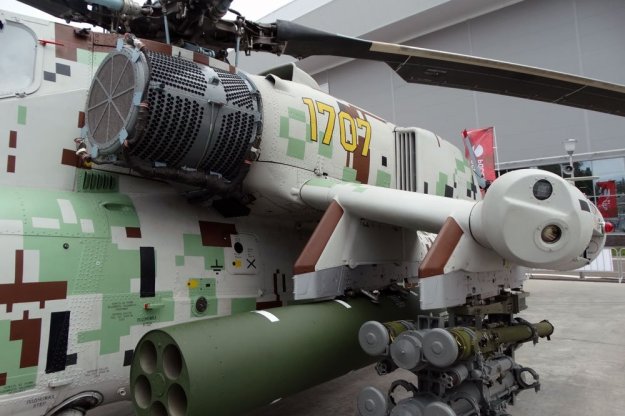 Alexey Brusilov
Alexey Brusilov
As the Russian Helicopters reported to the press service of the Helicopters of Russia holding, the exhibition featured multi-cyclone type dust protection devices designed to work in desert conditions, their efficiency being 20-23% higher than the base model.
The installation of the ROM does not affect the performance of the engine in any way, but they significantly reduce the erosion of the compressor blades, which makes it possible to work out the full life of the power plant before repair.
The development of this device was carried out within the framework of general measures to improve the flight performance and competitiveness of Russian attack helicopters.
Due to the successful operation of the Mi-28NE in a number of foreign states, the helicopter has already proved itself as a reliable and at the same time highly effective military means. The improvements carried out will allow to raise the car’s capabilities to an altitude that is even more unattainable for competitors. Source rg.ru
Cockpit
 Pilot
Pilot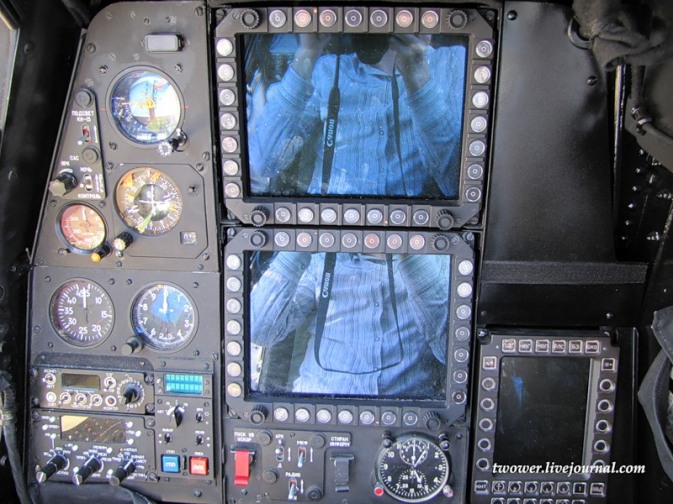 WSO
WSO New HUD
New HUD  The cockpit can withstand up to .50 cal
The cockpit can withstand up to .50 cal twower.livejournal.com
twower.livejournal.com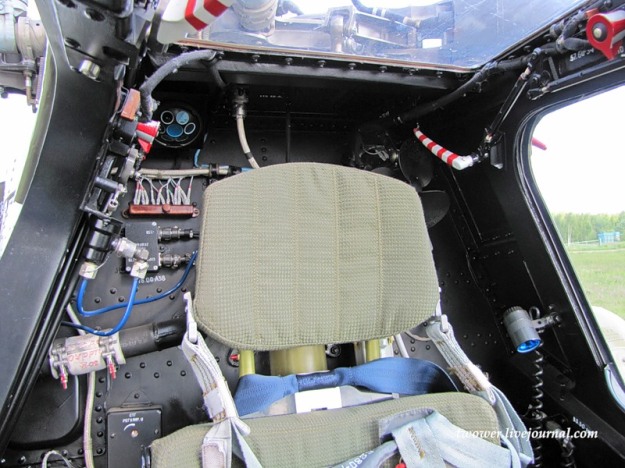 twower.livejournal.com
twower.livejournal.com
From the book of A. Mazepov, A. Mihkaev, V. Zenkin, A Zhirnov and A. Fomin about the Ka-50 called Polygon from 1996, on Page 31, there is said how the Armor was made on Ka-50 and after that also installed on Mi-28.
It is a 3 hardlinered armor, the inner cockpit section made of a full single titanium alloy “bathtub” covering both pilots, followed by a middle liner of ceramic plates, which caused trouble first after a single shot they break apart and lost all its protective abilities, they avoided that by covering this ceramic plates with kevlar/aramid that was glued on tightend and the outer liner which gives the aerodynamic shape and is made of alluminium alloy with a part carbon in it. The total armor per pilot for russian Ka-50 which they could use was about 300kg while the Apache uses about 90kg of armor per pilot. The Mi-28 has about 250-280kg which was mentioned somewhere else. The Ka-52 has less armor than both Mi-28 and Ka-50 spend for each pilot but it is still in the figure of 150-200kg. Source: Russian Defense
The design is based on the conventional pod and boom configuration, with a tail rotor. The five-blade main rotor is mounted above the body midsection, and short, wide, tapered, weapon-carrying wings are mounted to the rear of body midsection. Two turboshaft engines in pods are mounted alongside the top of the fuselage with downturned exhausts. The fuselage is slender and tapers to the tail boom and nose. The main rotor head has elastomeric bearings and the main rotor blades are made from composite materials. The Mi-28N boasts a new design of all plastic rotor blades, which can sustain hits from 30 mm shells. The non-retractable tricycle tail-wheel type energy-absorbing landing gear and seats protect the crew in a crash landing or in a low-altitude vertical fall. The cockpit is reinforced with armor and shock absorbers to protect both crew members and is equipped with advanced sensors for day, night and inclement weather conditions. The windshield, which withstands impact by 7.62 and 12.7mm bullets and 20mm shell fragments. Source strategic-culture.org
Mi-28NE’s armament and protection features
The Mi-28NE Night Hunter combat helicopter is armed with reliable guided weapon systems and missile launchers to destroy enemy aircraft and helicopters.
The helicopter can carry up to 16 Ataka-B air-to-ground missiles and eight short-range Igla man-portable surface-to-air missile systems. It is also armed with two Strelets air-to-air missiles, 80mm and 130mm S-13 rocket pods, B-8 V20A rocket pods with S-8 and B-13 L’1 weapons, and a movable weapon mount with a 30mm 2A42 cannon.
The helicopter offers fire protection for power equipment, hydraulic systems and other fire hazardous units and compartments. The engine compartment is insulated by airframe elements and the self-sealing fuel tanks are protected from explosion and fuel leakage.
Ataka-B air-to-ground missiles
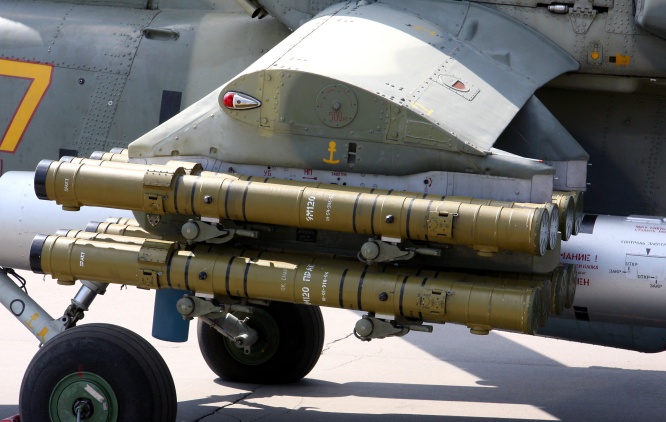 Ataka-B air-to-ground missiles
Ataka-B air-to-ground missiles
Igla man-portable surface-to-air missile systems
 Igla man-portable surface-to-air missile
Igla man-portable surface-to-air missile
B-8 V20A rocket pods
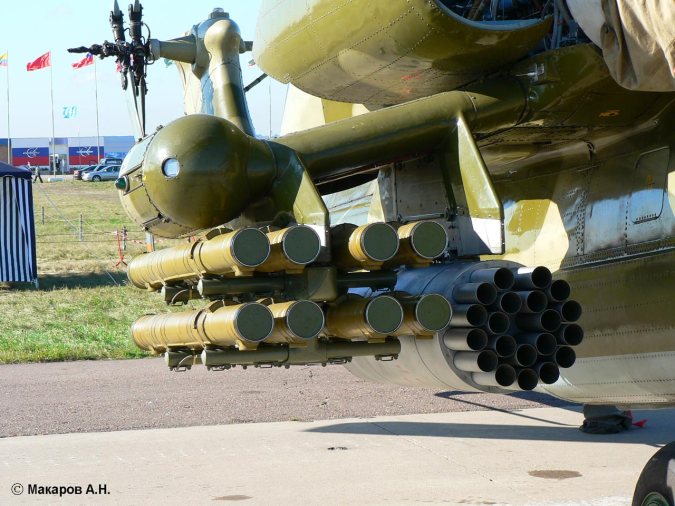 B-8 V20A rocket pods
B-8 V20A rocket pods
9K123 KHRIZANTEMA-S antitank missile system
Specifications of 9M123 and 9M123F antitank guided missiles
Maximum firing range: 5000 m, min.
Minimum firing range: 400 m.
Flight speed: Supersonic
9N146-1 warhead (9M123 missile): Tandem HEAT (armour penetration 1000 to 1100 mm behind ERA).
9N146F warhead (9M123F missile): HE (FAE, TNT equivalent 13.5 kg, min.).
The missile guidance system includes a radio receiver and a photodetector installed in the C&G section for respectively automatic radio beam or semi-automatic laser beam riding.
Warhead diameter: 155 mm.
Length of canitserized missile: 2300 mm.
Weight of canitserized missile: 62 kg, max.
Altitude for combat use of 9M123 and 9M123F missiles above sea level: Up to 3000 m.
Source kbm.ru
2A42 30mm automatic gun

The 30mm automatic gun is designed for firing at light armored targets within a distance up to 1500 m, non-armored targets within a distance up to 4000 m and also at low-flying subsonic air targets up to 2000 m within a slant distance of 2500m. The gun can be fired in single shots or in burst (low or high rate of fire). It offers reliable functioning under severe conditions, such as temperature range from +50°C up to -50°C, in rain, dust, frost and in very dry environment.
 30mm 2A42 cannon
30mm 2A42 cannon
TECHNICAL DATA OF 2A42
| Caliber | 30 mm | |
| Number of grooves | 16 | |
| Twist of grooves | 715,5 mm | |
| Rate of fire | high | min 550 rounds/min |
| low | 200-300 rounds/min | |
| Gun weight | 115 kg | |
| Barrel weight | 38,5 kg | |
| Recoiling force | 40-50 Kn | |
| Length of the gun | 3 027 mm | |
| Voltage of the trigger electric source, contact system | 27 +2/-5 V | |
| Feeding | Two belt type | |
| Recocking | Pyrotechnical or manual | |
| Number of powder cartridges | 3 | |
| Force required to cock the gun by hand for: | ||
| – loading | up to 400 N | |
| – re-loading with simultaneous extraction of misfired round | up to 600 N |
2A42 30mm specification source ztsspecial.sk
IMPROVED VERSION OF RUSSIAN MI-28NM ATTACK HELICOPTER SPOTTED IN MOSCOW
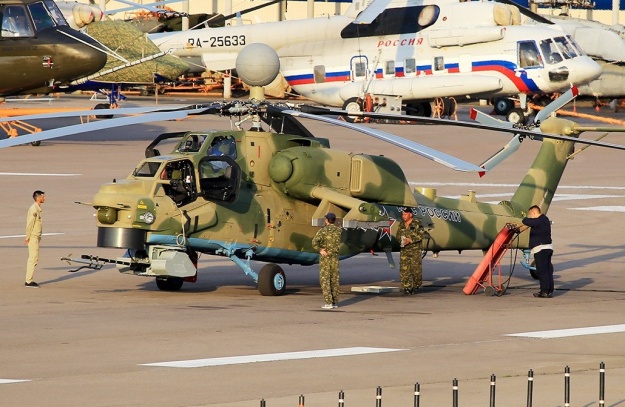
The improved version of Mi-28NM has been equipped with surveillance radar and a new control system, the RIA Novosti news agency reported earlier, citing the managing director of the Russian Helicopters (Rosvertol) company, Petr Motrenko. The new attack helicopter also has received improved rotor blades that will increase the cruising speed of the machine by 13% and the top speed – by 10%. According to rumors, the new version will be able to reach speed of 600 km/h (370 mph).
The Mi-28NM attack helicopter is producing at the Rosvertol plant in Rostov. The machine was designed to find and destroy tanks and other armored vehicles in conditions of active fire and electronic countermeasures. The helicopter also can hunt for low-speed air targets and infantry.
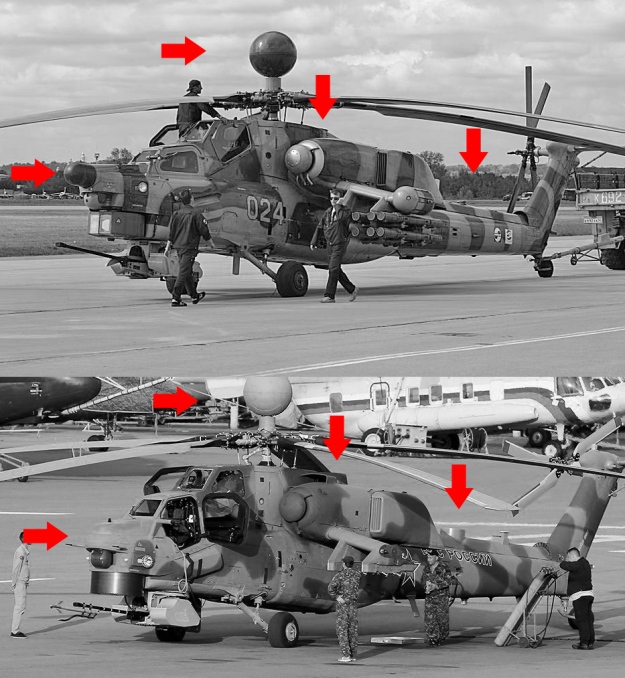 Image @planobrazil.com
Image @planobrazil.com
The letter ‘N’ (‘night’) in the name of the Mi-28NM shows the helicopter’s ability to work equally effectively at any time of a day. The helicopter modernization project provides for the installation of the radar antenna over the flapping hinge. In addition to the circular view it will enable the crew to monitor the situation, hiding in the folds of the terrain.
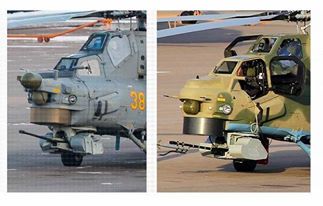 Image @planobrazil.com
Image @planobrazil.com
Weapon Director & Target Search, Tracking and Identification
| General data: | |
|---|---|
| Type: Visual | Altitude Max: 0 m |
| Range Max: 83.3 km | Altitude Min: 0 m |
| Range Min: 0 km | Generation: LLTV, 3rd Generation (2000s/2010s) |
| Properties: Identification Friend or Foe (IFF) [Side Info], Classification [Class Info] / Brilliant Weapon [Automatic Target Aquisition], Continous Tracking Capability [Visual], LLTV / NVG / CCD (Night-Capable) / Searchlight [Visual Night-Capable] |
| Sensors / EW: |
|---|
| Generic LLTV – (3rd Gen, Weapon Director & Target Search, Tracking and Identification) Visual Role: LLTV, Weapon Director & Target Search, Tracking and Identification Max Range: 83.3 km |
FLIR
| General data: | |
|---|---|
| Type: Infrared | Altitude Max: 0 m |
| Range Max: 55.6 km | Altitude Min: 0 m |
| Range Min: 0 km | Generation: Infrared, 3rd Generation Imaging (2000s/2010s, Impr LANTIRN, Litening II/III, ATFLIR) |
| Properties: Identification Friend or Foe (IFF) [Side Info], Classification [Class Info] / Brilliant Weapon [Automatic Target Aquisition], Continous Tracking Capability [Visual] |
| Sensors / EW: |
|---|
| Generic FLIR – (3rd Gen, Weapon Director & Target Search, Tracking and Identification FLIR) Infrared Role: Infrared, Weapon Director & Target Search, Tracking and Identification FLIR Max Range: 55.6 km |
Laser Designator (Surface Only)
| Sensors / EW: |
|---|
| Generic Laser Designator – (Surface Only) Laser Designator Role: Laser Target Designator & Ranger (LTD/R) Max Range: 18.5 km |

“The radar is able to process information from multiple channels at the same time that helps to improve accuracy of the measurement of the coordinates and parameters of obstacles. The number of simultaneously tracked targets has been increased, new modes have been developed. Performance-board computer has been increased ten times,” Pavel Budagov, the Director of the Ryazan instrument factory, where the radar was developed, said.
The Mi-28NM has also been equipped with a dual control system – the machine can also be operated by the navigator-operator. Source southfront.org

ZSh-10 with NSCI spotted during the Mi-28NM tests
Avionics on board Mi-28NE Night Hunter
The Mi-28NE Night Hunter combat helicopter is equipped with an advanced set of integrated avionics suites for automatic detection and tracking of targets during combat missions.
KRET’s Ohotnik automatic thermal television system is installed to perform intellectual processing of video images and a high-speed digital interface is used to transmit video signals.
The helicopter is fitted with a helmet-mounted target identification and indication system to project images onto the visor and to determine the direction of proliferation automatically. An optical-electronic system is used to process the information collected by the helmet system. It is also used for observation, navigation and fire control tasks.
 Helmet-mounted target identification and indication system to project images onto the visor
Helmet-mounted target identification and indication system to project images onto the visor
The helicopter also incorporates KRET’s airborne radar system and a receiving-transmitting antenna module to detect dangerous objects and meteorological formations. The radar enables the helicopter to remain invisible to the enemy. Other equipment aboard the Mi-28NE includes a dual-control system, CV-28 M round-the-clock target sight system, and a laser system.
N025 radar
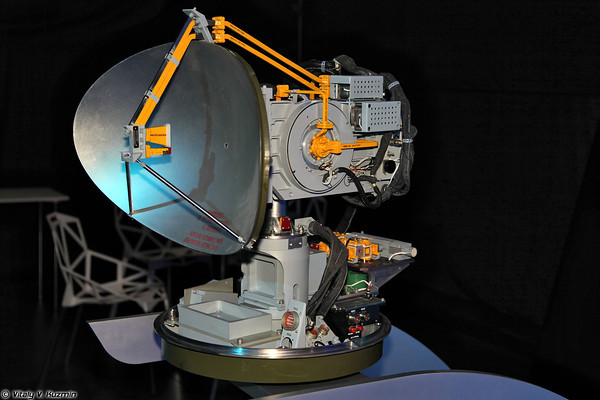 N-025E radar
N-025E radar
The new N025 radar is unique in that its receiving and transmission antenna module is located on the helicopter’s rotor. Since the radar revolves around a fixed point, it can provide 360-degree visibility.
Normally, helicopter radars are located on the bow, meaning the aircraft must turn around if it wants to see what is happening behind it.
According to Vladimir Mikheev, Advisor to the First Deputy CEO of KRET, the range and detection capabilities of the new radar developed by the concern exceed the requirements of tactical and technical specifications and have no analogues in Russia.
As previously reported, the updated Night Hunter will also feature a new control system and “electronic cabin.” The Mi-28N helicopter’s avionics already correspond to the requirements of the fifth-generation aircraft equipment. Its primary developer, Ramensky Instrument Design Bureau (RPKB), is a KRET subsidiary. KRET specialists also plan on installing electronic warfare systems on the Night Hunter. Source kret.com

| General data: | |
|---|---|
| Type: Radar | Altitude Max: 0 m |
| Range Max: 37 km | Altitude Min: 0 m |
| Range Min: 0.2 km | Generation: Early 2000s |
| Properties: Periscope/Surface Search – Fine Range Resolution + Rapid Scan [1980+], Periscope/Surface Search – Advanced Processing [2000+], Pulse Doppler Radar (Full LDSD Capability) |
| Sensors / EW: |
|---|
| N-025 Arbalet – (Mi-28,Mast Mounted Radar) Radar Role: Radar, FCR, Air-to-Air & Air-to-Surface, Short-Range Max Range: 37 km |
Source cmano-db.com
KRET unveils N025E mast-mounted helicopter radar
 The export-oriented N025E mast-mounted radar was unveiled at HeliRussia 2018. (Nikolai Novichkov)
The export-oriented N025E mast-mounted radar was unveiled at HeliRussia 2018. (Nikolai Novichkov)
Russia’s Radio-Electronic Technologies Concern (KRET) – a subsidiary of the Rostec state corporation – unveiled the N025E mast-mounted radar for the Mil Mi-28N/NE ‘Havoc-B’ combat helicopters during the HeliRussia 2018 exhibition in Moscow.
The N025E is an all-weather, Ka-band radar that is designed to detect moving and stationary objects. It comprises a swivelling parabolic antenna and a processing unit, with the antenna housed in a mast-mounted dome above the main rotor and the processing unit integrated into the helicopter’s fuselage.
The radar can perform simultaneous tracking of up to four ground or air target at ranges of up to 20 km, and facilitates low-level flight by keeping track of obstacles. It can also detect a dangerous meteorological formation out to 100 km.
It has a traverse angle of 180° and a field of view of -25° to +15°, and searches for ground targets in a 90° sector with a deflection angle of 35°. Source janes.com
SPO-32 / L150 Pastel digital receiver
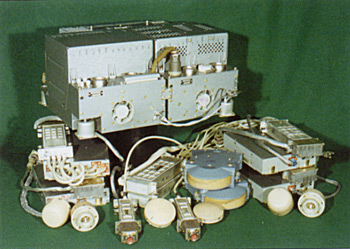
Pastel entered development in 1982, possibly as a reaction to poor performance of Soviet fighters in the Middle East. By 1983 the initial design was produced. It was intended for the Mi-28, MiG-29K/M, Su-27M and others.
Pastel is a family of new generation digital RWRs.
Su-25TM installation
Scans from 1.2-18GHz threat frequencies.
Accuracy is 3-5° with pinpoint location antenna, 10° in rough location antenna. 128 reprogrammable radar types. Detection range minimum of 120% of the radar’s range. 3 modes- operational target, programmed target, most dangerous target.
Detects and finds direction for pulse, pulse-doppler and CW mode radars in search, track and illumination modes. Classifies multiple threats by danger, with full display of all information about most threatening radar presented to crew. Controls EW systems, has the ability to control and assign targets to 6 anti-radiation missiles such as the Kh-31. Aural warnings for high threat situations.
Pastel may be made available for upgrade packages or built into new export models of the Mig-29 and Su-27 families. Source aerospace.boopidoo.com
| General data: | |
| Type: ESM | Altitude Max: 0 m |
| Range Max: 222.2 km | Altitude Min: 0 m |
| Range Min: 0 km | Generation: Early 2000s |
| Sensors / EW: |
| SPO-32 Pastel [L-150] – ESM Role: RWR, Radar Warning Receiver Max Range: 222.2 km |
Source cmano-db.com

 Small compartment which can ferry at most 2 individuals in case of emergencies
Small compartment which can ferry at most 2 individuals in case of emergencies
Operators: Here
The latest Mi-28UB ready for mass production: Here
Excerpt
Rostov helicopter production complex “Rostvertol” starts serial production of the new training helicopter Mi-28UB, the press service of the defense Ministry with reference to Deputy Minister Yuri Borisov.
Russia produces first serial Mi-28UB combat training helicopter (PHOTOS): Here
Excerpt
Helicopter propulsion and performance
The Mi-28NE Night Hunter is powered by two VK-2500 turboshaft engines manufactured by Klimov. Each engine generates a maximum take-off power of 2,200hp.
The helicopter can climb at a rate of 13.6m/s and has a service ceiling of 5,600m. The cruise and maximum speeds are 270km/h and 300km/h respectively, while the range is about 435km.
2 x VK-2500 turboshaft engines

Improved Safety
Should one of he engines fail, the flight safety is greatly enhanced owing to the emergency power feature (2700 hp) of the VK-2500 engine.
Flexible power options and trouble-free maintenance
The engine can be adjusted to use any of the three horsepower options available depending on the customer’s preference. This choice helps take full advantage of the helicopter’s features as well as save fuel.

FACTS
-
Developed in 2001
-
Power class – 2500 hp
-
Installed on modified Mi-17 and Ka-32 helicopters, as well as on Mi-28, Ka-52 and Mi-35 modern fighter helicopters
-
VK-2500 engines are installed on helicopters that serve mountain rescue units of the Russian Ministry of Emergency Situations.
-
VK-2500 engines as components of a MI-17-V5 power plant passed tests in the mountains of Tibet.
-
The service life of a VK-2500 may reach 9,000 hours.
-
A perfect upgrade for helicopters equipped with TV3-117 engines.
Principal specifications of the VK-2500 engine:
| Horsepower options | I | II | III |
| Emergency performance (Н=0, V=0): | |||
| power (ISA+150С), hp | 2700 | 2700 | 2700 |
| Takeoff performance (Н=0, V=0): | |||
| power (ISA+30/25/150С), hp | 2000 | 2200 | 2400 |
| specific fuel consumption, (ISA), g/hp/hr, no higher than | 220 | 214 | 210 |
| Cruising performance (Н=0, V=0): | |||
| power (ISA+25/25/150С), hp | 1500 | 1500 | 1750 |
| Dimensions, mm: | |||
| Length | 2055 | 2055 | 2055 |
| Width | 660 | 660 | 660 |
| Height | 728 | 728 | 728 |
| Weight, kg | 300 | 300 | 300 |
Source klimov.ru
General characteristics
- Crew: 1 pilot (rear), 1 navigator/weapons operator (front)
- Length: 17.91 m (58 ft 9 in)
- Rotor diameter: 17.20 m (56 ft 5 in)
- Height: 3.82 m (12.5 ft (150 in))
- Disc area: 232.35 m² (2,501 ft²)
- Empty weight: 7,890 kg (17,400 lb)
- Loaded weight: 10,500 kg (23,150 lb)
- Max. takeoff weight: 11,700 kg (25,800 lb)
- Powerplant: 2 × Klimov TV3-117 turboshaft, 1,636 kW (2,194 shp) each
Russia launches new engine production for military helicopters: Here
Performance
Primary weapons:
Possibilities:
Defense suite:
Crew survivability is provided by:
Source: Air Force Technology, Wiki, Russian Defense, russianhelicopters.aero
Images are from public domain unless otherwise stated
Main image Laith Jobran @flickr
Updated Sep 11, 2018






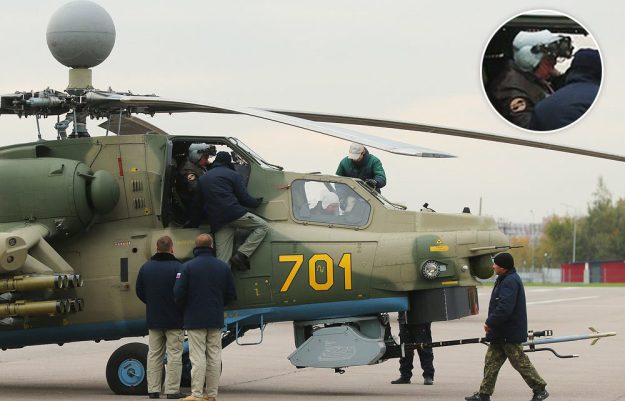



Pingback: AH-1Z si concurenta... protectie si costuri - Romania Military